|
|
|
Sort Order |
|
|
|
Items / Page
|
|
|
|
|
|
|
| Srl | Item |
| 1 |
ID:
113692


|
|
|
|
|
| Publication |
2012.
|
| Summary/Abstract |
In this paper, we emphasize the interactive effect between life expectancy and human capital accumulation, and test the positive feedback of longevity to educational investment in China. This is very important for understanding the pressure from the aging population and the increase in private educational investment in China. We first show in an extended human capital investment model that life expectancy growth acts as a driving force for educational investment. We then build a difference-in-difference-in-differences empirical framework and use cross-province data to examine the effect in China. We use the maternal mortality rate (MMR) to identify the difference in life expectancy between genders, and the illiteracy rate or average years of education by gender for educational investment. The empirical results comply with the theory, in that increases in life expectancy significantly lower illiteracy rates and improve the average schooling years in China. This content of the present paper is closely related to crucial issues like population aging, human capital accumulation and gender discrimination. Policy implications are discussed based on the empirical results.
|
|
|
|
|
|
|
|
|
|
|
|
|
|
|
|
| 2 |
ID:
103962
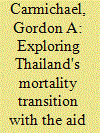

|
|
|
|
|
| Publication |
2011.
|
| Summary/Abstract |
The project Thai Health-Risk Transition: A National Cohort Study seeks to better understand the health implications of modernisation and globalisation forces impacting on Thailand. As part of its 'look-back' component this paper seeks, using available life tables, to document the country's post-war mortality transition. The onset of transition through mass campaigns of the late 1940s and 1950s is first discussed before attention turns to the life tables. They are predictably far from flawless, but careful analysis does permit trends that have seen around 30 years added to life expectancy to be traced, and age patterns of improved survivorship and their relation to initiatives to improve health to be examined. The broad benefits generated by mass campaigns, ongoing improvements in infant and early childhood mortality, and a phased impact of the expansion of primary health care in rural areas on adult survival prospects after the mid-1970s are demonstrated. The paper also investigates the consequences for mortality of a motorcycle-focused rapid increase in road fatalities in the late 1980s and early 1990s and the HIV/AIDS epidemic that developed after 1984.
|
|
|
|
|
|
|
|
|
|
|
|
|
|
|
|
| 3 |
ID:
143333


|
|
|
|
|
| Summary/Abstract |
The recent female literacy and fertility levels in Kerala state are examined using the 2011 census data. Arriaga’s approach for estimation of age-specific fertility rates is undertaken to show the particularities of Kerala state and the best practices which made this state an example for other states in India as well as other places in the world, particularly developing countries. Women’s empowerment gets as much credit as physical facilities and family planning programs; this empowerment level of women is also related to their level of education.
|
|
|
|
|
|
|
|
|
|
|
|
|
|
|
|
| 4 |
ID:
156537
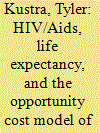

|
|
|
|
|
| Summary/Abstract |
This article views death in battle as an opportunity cost whose size is determined by the number of years a rebel would have lived as a civilian. As civilian life expectancy declines, this opportunity cost does too, increasing the probability of rebellion. This theory is tested with a tragic natural experiment: the HIV/AIDS epidemic in sub-Saharan Africa. Using male circumcision rates as an instrument for life expectancy, the analysis shows that a one-year increase in life expectancy decreases the probability of civil war by 2.6 percentage points. This supports the theory that opportunity costs are important determinants of conflict onset and that nonpecuniary opportunity costs should be taken into account. This article concludes by noting that cost–benefit analyses of public health interventions should include decreases in the probability of civil war, and the attendant benefits in terms of lives saved and material damage prevented, in their calculations.
|
|
|
|
|
|
|
|
|
|
|
|
|
|
|
|
| 5 |
ID:
183995
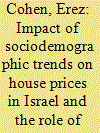

|
|
|
|
|
| Summary/Abstract |
This article examines the impact of sociodemographic trends in marriage, divorce, and rising life expectancy in different districts in Israel on the increase in the number of households and, in turn, on the rising house prices in each of the districts. The findings show that in 2008–17, the Tel Aviv, Jerusalem, and Central districts, which had higher marriage, divorce, and life expectancy rates compared to other districts not only had the largest annual increment in the total number of households but also saw a particularly steep rise in house prices compared to a more moderate rise in the other districts and outlying areas. This state of affairs requires the formulation of a public policy capable of influencing demand and supply pressures in the house market in the various districts, with the aim of regulating house prices in accordance with national needs and government strategies for spreading the population throughout the country.
|
|
|
|
|
|
|
|
|
|
|
|
|
|
|
|
| 6 |
ID:
161490
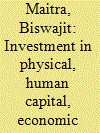

|
|
|
|
|
| Summary/Abstract |
This article studies the efficacy of the public investment in human capital and physical capital to raise income in Bangladesh over the period 1980–2016. This article also assesses whether the investment in human capital and income have raised life expectancy of the country. The Johansen cointegration test identifies a long-run relation of income with investment on education, health care and physical capital. The error correction mechanism (ECM) based on the cointegrating relation followed by the Wald test of Granger causality has found that these investments have caused income to rise with some lag periods. Robustness of these findings is confirmed by involving an autoregressive distributed lag (ARDL) model of cointegration followed by its ECM representation. On the other hand, the Johansen and ARDL methods of cointegration followed by their ECMs have also found a long-run relation of life expectancy with the investment in education, health care and income. A decisive role of the investment in health care and income on life expectancy is observed, while an unusual negative role of the investment in education is also found. However, positive value of the long-run coefficients of the education and health-care investments of the ECM-ARDL model indicate some long-run favourable impact of these investments on life expectancy in Bangladesh.
|
|
|
|
|
|
|
|
|
|
|
|
|
|
|
|
| 7 |
ID:
123867


|
|
|
|
|
| Publication |
2013.
|
| Summary/Abstract |
A frequent empirical approach toward examining the impact of health on economic growth has been to focus on data for a cross-section of countries and to regress the income indicator on the health indicator controlling for the initial level of income and for other factors believed to influence steady-state income levels. From the methodological perspective, such a growth regression approach has mainly offered evidence for the relationship between health and income, using cross-country macro-level data. This article contributes to existing empirical research by introducing within-country regional-level analysis using three rounds of the Demographic and Health Surveys of Bangladesh, combined with corresponding geo-referenced global positioning system (GPS) data, to estimate the contribution of life expectancy to economic well-being. The joint evolution of the regional-level longevity and wealth indicator obtained from the micro-data corroborates Preston's cross-country macro-level findings. Also, the finding that a 1 per cent increase in life expectancy leads to about 3 per cent increase in the wealth index corroborates the findings of several macro-regression studies and promotes the concept of direct investments in health.
|
|
|
|
|
|
|
|
|
|
|
|
|
|
|
|
| 8 |
ID:
144812
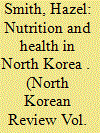

|
|
|
|
|
|
|
|